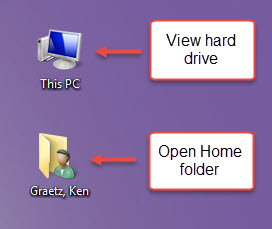Difference between revisions of "Draft:Backing up files on your PC"
| Line 45: | Line 45: | ||
*[[Receiving your laptop and tablet]] | *[[Receiving your laptop and tablet]] | ||
*[[E-Warrior Digital Life and Learning Program]] | *[[E-Warrior Digital Life and Learning Program]] | ||
| + | _NOTOC_ | ||
[[Category:PC]][[Category:Laptop Exchange]][[Category:Backup]] | [[Category:PC]][[Category:Laptop Exchange]][[Category:Backup]] | ||
| − | |||
Revision as of 14:09, 29 June 2015
About this article
This article includes links to instructions and information about the various options for school-related and personal file storage on your WSU Windows-based, HP EliteBook provided through the E-Warrior Digital Life and Learning Program or your WSU desktop. Use this information as part of your normal backup routine or to prepare for a laptop exchange or re-imaging. It is intended for students and employees.
Before you begin
Before you start copying and pasting files, please consult the following articles as needed:
- How much data do you have to back up? You can check how much space you are using on your current laptop's hard drive to estimate how much room you will need to back up your files.
- Where are your files? Do you know where all your files are located? Make sure to check the most common storage locations.
- Do you have family photos, home movies, and other personal files stored on your laptop? Consult our policies and guidelines regarding the appropriate, personal use of WSU computing resources.
- Are you backing up private university data? Learn more about where such data can and can't be stored.
- PC laptop backup FAQ
When it comes to storing school-related and personal files, you have several choices:
Microsoft OneDrive for Business
This is our "cloud storage" solution, a fancy way of saying that your data is stored on off-campus servers owned by Microsoft. Once you have stored your files in your OneDrive for Business, you can access them from any computer with an Internet connection, anywhere in the world. You can also access your OneDrive for Business using a tablet or smartphone. This is the only cloud storage option supported by WSU.
WSU personal network storage (employees only)
Sometimes referred to as your "R Drive," this campus storage space can be accessed from your laptop while on campus and from off campus using VPN. Students do not have this storage option.
External storage media
WSU can only provide limited support for SD cards and external hard drives and they cannot be used to store private university data, but they are a popular storage choice. Use them at your own risk.
Copying your Home folder
A quick way to back up most of the files you have stored on your hard drive is to make a copy of your Home folder. This is the folder on your desktop labeled with your name (Fig 1). Your Home folder contains all of the default folders created for you when you received your computer, including your Documents, Music, and Pictures folders. It also includes your Desktop folder.
Next copy your bookmarks and application specific files
- Go back to the checklist for information on how to back up your bookmarks and data stored by applications.
Related information
- PC laptop backup
- PC laptop backup FAQ
- Receiving your laptop and tablet
- E-Warrior Digital Life and Learning Program
_NOTOC_

